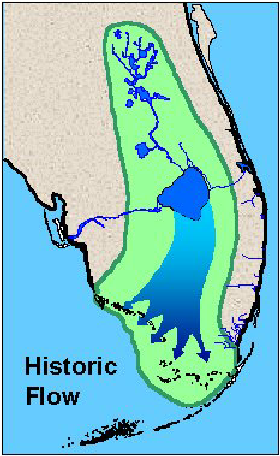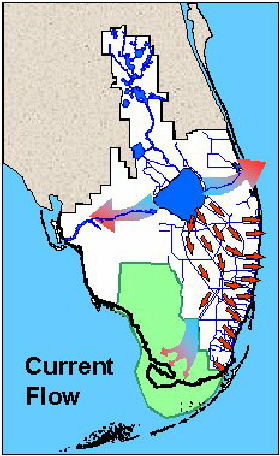The Takeaway Message
The U.S. Army Corps of Engineers is beginning to plan for a new Everglades restoration project — adding to the $7.4 billion already dedicated to restoration efforts over the next 10 years. Meanwhile, wading birds are returning to historic nesting sites in the Everglades, but in lower numbers.
What’s going on?
With a project derived from the Biscayne Bay and Southeastern Everglades Ecosystem Restoration Feasibility Study, the U.S. Army Corps of Engineers is planning to remove some unnatural barriers caused by manmade canals and levees in South Florida. The extensive system of canals and levees was built to drain and redirect water through the swampy land in order to grow crops, store and transport water to developed areas and prevent flooding to homes and businesses.
Although the manmade structures have met those objectives, they have transformed the natural landscape drastically and obstruct the natural flow of water through the Everglades and into Florida Bay. The project intends to rehydrate and restore the natural flow of water to coastal habitats, like mangroves and seagrasses, that have suffered from decades of over-draining.


One of the major goals of the project is to restore the natural hydrology destroyed by the Aerojet canal — a wide and deep system built in the 1960s to transport rocket engines from South Florida to Cape Canaveral.
The Corps predicts that it will take three years to fully develop the $3 million project plan and get it approved by Congress. But because the plan is not yet approved, its cost is not factored into the estimated $7.4 billion needed for the next ten years’ worth of other Everglades restoration projects. For some perspective, $6 billion was spent on Everglades restoration in 2019 alone. These efforts are all part of the wide-ranging, multibillion-dollar Everglades restoration project known as “CERP,” the Comprehensive Everglades Restoration Plan.
More than 50 ongoing projects and three planning studies are currently underway as part of the CERP effort. These efforts, on top of the numerous other plans awaiting authorization, make up the largest environmental restoration program in history.
Amidst restoration efforts, fewer wading birds are returning to the Everglades. According to the South Florida Wading Bird Report, current nesting numbers are only 72% of their 10-year average. South Florida Water Management District avian ecologist Mark Cook told the Miami Herald that flooded foraging grounds due to heavy rain were responsible for the poor nesting season, as birds weren’t able to find enough food to feed their chicks. The population levels of these wading birds are an indicator of the health of the Everglades, so their drop in numbers is troubling, officials say.
Why it Matters
Stretching across 1.5 million acres, South Florida’s famous Everglades ecosystem is one of the most diverse wetland landscapes on the planet. Traditionally home to the Miccosukee Tribe of Indians of Florida as well as numerous rare and endangered species, the Everglades is a unique and critical landscape like nothing else in the world.
The ecosystem acts as a sponge, storing and filtering water that roughly 8 million Floridians rely on. The vast wetland also naturally improves water quality by filtering out pollutants and absorbing excess nutrients. On top of that, the Everglades contain essential habitat for endangered and threatened flora and fauna like Florida panthers, piping plovers and West Indian manatees.
But half a century of dredging and diking to make the land more hospitable to humans has altered the natural water flow patterns, causing ecological damage that we’re dealing with today.
For example, the problematic Aerojet canal is estimated to collect at least three-quarters of the water that once flowed into Florida Bay, a significant cause of the current salinity and water flow issues in the southern Everglades. According to the Corps, the proposed project would eliminate sections of the canal to help increase freshwater flow through the Everglades and into Florida Bay.
This increased freshwater could help restore seagrass beds and other habitats that have been pushed out by mangroves due to higher salinity, or salt, levels. The plan’s corrected water flow would also provide relief for an array of estuarine species — such as fish, crabs and wading birds — whose habitats have been compromised due to the lack of freshwater flow and resulting high salinity.
Wading birds are thought to be an indicator of health in South Florida habitats, so their population level throughout the Everglades is closely monitored by the SFWMD. The Corps projects would improve the habitats of these birds, allowing them to successfully stay in their historic nesting areas.
What can I do?
- Contact the U.S. Army Corps of Engineers to share your thoughts on the CERP and BBSEER plans by emailing BBSEERcomments@usace.army.mil.
- Learn about ongoing threats to the Everglades.
- Read up on the history of manmade canals and levees in South Florida.
Learn more:
- About the significance of the Everglades and how it can be protected
- About the Comprehensive Everglades Restoration Plan (CERP)
- About why it’s important to restore the Everglades
Other noteworthy Florida Waterways news:
- DEP Hosts Online Blue-Green Algae Task Force Meeting
- Roughly $3M goes into coral work
- Collier, feds partner for $3B coastal resiliency efforts
- $11 million spent for land near Santa Fe River to protect springs
- Federal Judge Orders Army Corps To Study Toxic Algae In Lake O Releases
- Deadly bacteria lurk in coastal waters. Climate change increases the risks.